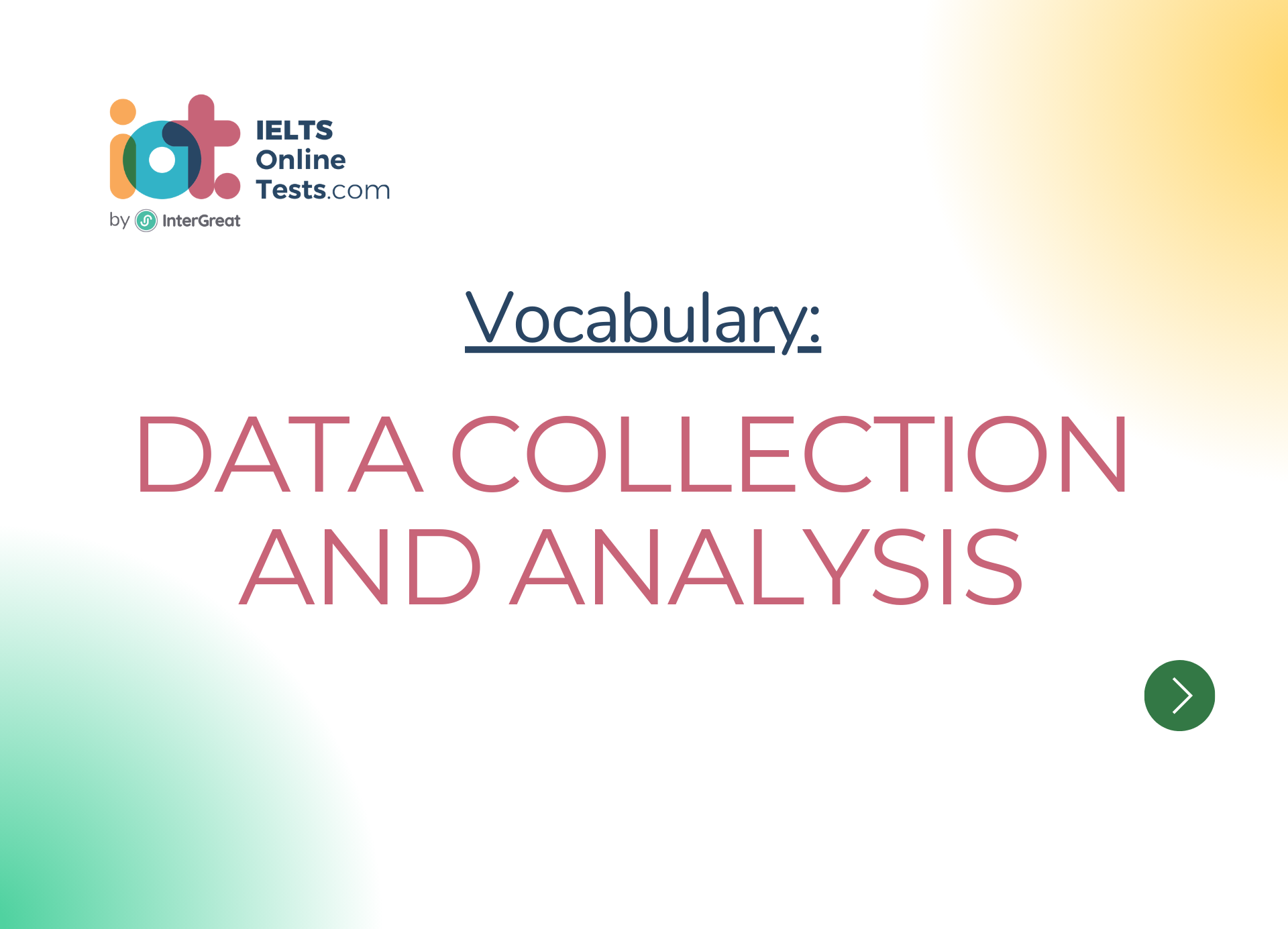
Data collection and analysis
Data collection and analysis are essential components of the research process. A solid understanding of the vocabulary related to data collection methods and data analysis techniques can help you effectively design and conduct research studies. Here's a comprehensive list of vocabulary related to data collection and analysis, suitable for the IELTS band score range of 6.5-8.0:
Data Collection Methods:
Surveys: Questionnaires or interviews used to gather data from a sample of individuals.
Observational Studies: Gathering data by directly observing and recording behaviors in a natural or controlled setting.
Experiments: Controlled investigations designed to test cause-and-effect relationships between variables.
Case Studies: In-depth analysis of a single individual, group, or organization over time.
Content Analysis: Systematically analyzing and categorizing the content of textual or visual data.
Focus Groups: Facilitated group discussions with participants to explore their views and experiences.
Interviews: Structured or semi-structured conversations with participants to obtain information.
Secondary Data Analysis: Analyzing existing data collected by others for a different purpose.
Data Collection Instruments:
Questionnaires: Written sets of questions used in surveys to collect data from respondents.
Interview Guides: Structured outlines used to guide the conversation during interviews.
Observation Checklists: Lists of specific behaviors or events to be observed and recorded.
Scales: Instruments used to measure attitudes, opinions, or perceptions of participants.
Sensors: Devices that collect data on physical parameters, such as temperature or heart rate.
Audio/Video Recorders: Devices used to record interviews, focus groups, or observations for later analysis.
Sampling Techniques:
Probability Sampling: Sampling techniques where every member of the population has a known chance of being selected.
Simple Random Sampling: Selecting participants randomly from the entire population.
Stratified Sampling: Dividing the population into subgroups and then randomly sampling from each subgroup.
Cluster Sampling: Randomly selecting groups (clusters) from the population and sampling all members within the selected clusters.
Non-Probability Sampling: Sampling techniques where not every member of the population has an equal chance of being selected.
Convenience Sampling: Choosing participants who are readily available and easily accessible.
Snowball Sampling: Participants referring other potential participants for recruitment.
Purposive Sampling: Handpicking participants based on specific criteria that align with the research objectives.
Data Analysis Techniques:
Descriptive Analysis: Summarizing and presenting data using measures such as mean, median, and frequency distribution.
Inferential Analysis: Drawing conclusions or making predictions about a population based on sample data.
Statistical Tests: Methods used to determine the significance of relationships or differences in quantitative data.
Chi-square Test: A statistical test to determine the association between two categorical variables.
T-test: A statistical test to compare the means of two groups.
ANOVA (Analysis of Variance): A statistical test to compare the means of three or more groups.
Regression Analysis: Analyzing the relationship between a dependent variable and one or more independent variables.
Factor Analysis: Identifying underlying factors that explain the variance in a set of observed variables.
Content Analysis: Identifying patterns and themes in qualitative data through systematic analysis.
Data Visualization: Representing data graphically to facilitate understanding and interpretation.
Data Interpretation and Presentation:
Tables: Organized data presentation in rows and columns for easy comparison.
Charts and Graphs: Visual representations of data, such as bar charts, line graphs, and pie charts.
Figures: Visual elements used to illustrate specific findings, often in research papers or reports.
Narratives: Descriptive explanations and interpretations of data findings.
Statistical Significance: The likelihood that a result is not due to chance but rather a real effect.
Data Quality and Reliability:
Validity: The accuracy and appropriateness of research findings and conclusions.
Reliability: The consistency and stability of measurements and results over time and across different conditions.
Bias: Systematic errors that affect the accuracy or validity of data.
Generalizability: The extent to which research findings can be applied to a larger population.
Triangulation: Using multiple data sources or methods to validate research findings.
Data Ethics:
Informed Consent: Obtaining voluntary and informed agreement from research participants before their involvement.
Anonymity: Ensuring that the identities of research participants are not linked to their data.
Confidentiality: Protecting the identity and data of research participants to ensure privacy.
Data Protection: Safeguarding data from unauthorized access or disclosure.
Data Ownership: Defining who has the rights to use and control the collected data.
Statistical Software:
SPSS (Statistical Package for the Social Sciences): A software package used for statistical analysis in the social sciences.
SAS (Statistical Analysis System): A software suite used for advanced analytics, business intelligence, and data management.
R: A programming language and software environment for statistical computing and graphics.
Python: A versatile programming language widely used in data analysis and machine learning.
Excel: A spreadsheet program often used for basic data analysis and visualization.
Interpreting Research Findings:
Implications: The practical or theoretical consequences of research findings.
Limitations: Recognizing and acknowledging the constraints and potential biases in the research.
Recommendations: Suggestions for future research or practical applications based on the study's findings.
Remember to use these terms appropriately when discussing data collection methods, analysis techniques, data interpretation, and ethical considerations in academic and research contexts. Keep practicing and expanding your knowledge of data analysis vocabulary to enhance your academic proficiency and achieve a higher IELTS band score. Happy studying!




